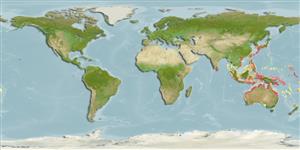Environment: milieu / climate zone / depth range / distribution range
Ecology
Marine; freshwater; brackish; benthopelagic; amphidromous; depth range 0 - 5 m (Ref. 86942). Tropical; 20°C - 28°C (Ref. 13614)
Indo-West Pacific: Sulawesi, Indonesia to western and eastern Australia and New Caledonia.
Size / Weight / Age
Maturity: Lm ? range ? - ? cm
Max length : 40.0 cm SL male/unsexed; (Ref. 48637)
Dorsal spines (total): 7 - 12; Dorsal soft rays (total): 16; Anal spines: 4; Anal soft rays: 15 - 16. Greenish or silvery; individuals greater than 4 cm SL with 7 to 12 narrow dark vertical bars on dorsal half of flanks and with spots, usually smaller than eye, more or less arranged in vertical rows in ventral half; lips black; posterior edge of caudal fin and soft portions of anal and dorsal fins with a narrow black margin which disappear in individuals larger than 6 cm SL (Ref. 43044).
Found in coastal estuaries, river entrances and rock pools (Ref. 9002, 44894). Inhabits mangrove creeks and the lower reaches of freshwater streams (Ref. 44894). Anterolateral glandular groove with venom gland (Ref. 57406). Sometimes sold fresh in markets (Ref. 43044). Juveniles collected for the aquarium trade (Ref. 43044).
Life cycle and mating behavior
Maturity | Reproduction | Spawning | Eggs | Fecundity | Larvae
Kottelat, M., 2001. Scatophagidae. Scats. p. 3623-3626. In K.E. Carpenter and V. Niem (eds.) FAO species identification guide for fishery purposes. The living marine resources of the Western Central Pacific. Vol. 6. Bony fishes part 4 (Labridae to Latimeriidae), estuarine crocodiles. FAO, Rome. (Ref. 43044)
IUCN Red List Status (Ref. 130435: Version 2024-1)
Human uses
Fisheries: minor commercial; aquarium: commercial
Tools
Special reports
Download XML
Internet sources
Estimates based on models
Preferred temperature (Ref.
123201): 21.4 - 29.3, mean 28.4 °C (based on 2076 cells).
Phylogenetic diversity index (Ref.
82804): PD
50 = 0.8125 [Uniqueness, from 0.5 = low to 2.0 = high].
Bayesian length-weight: a=0.02570 (0.01005 - 0.06572), b=2.96 (2.75 - 3.17), in cm total length, based on LWR estimates for this (Sub)family-body shape (Ref.
93245).
Trophic level (Ref.
69278): 2.9 ±0.3 se; based on size and trophs of closest relatives
Resilience (Ref.
120179): High, minimum population doubling time less than 15 months (Preliminary K or Fecundity.).
Fishing Vulnerability (Ref.
59153): Moderate vulnerability (39 of 100).
